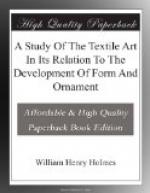Now, if we examine these woven forms with reference to the modifications brought about by the textile surveillance, we find that the figures, as introduced in the cloth, do not at all correspond with those executed by ordinary graphic methods, either in degree of elaboration or in truthfulness of expression. They have a style of their own. Each delineative element upon entering the textile realm is forced into those peculiar conventional outlines imposed by the geometric construction, the character of which has already been dwelt upon at considerable length. We find, however, that the degree of convention is not uniform throughout all fabrics, but that it varies with the refinement of the threads or filaments, the compactness of the mesh, the character of the combination, the graphic skill of the artist, and the tendencies of his mind; yet we observe that through all there is still exhibited a distinct and peculiar geometricity.
So pronounced is this technical bias that delineations of a particular creature—as, for example, a bird—executed by distant and unrelated peoples, are reduced in corresponding styles of fabric to almost identical shapes. This conventionalizing force is further illustrated by the tendency in textile representation to blot out differences of time and culture, so that when a civilized artisan, capable of realistic pictorial delineation of a high order, introduces a figure into a certain form of coarse fabric he arrives at a result almost identical with that reached by the savage using the same, who has no graphic language beyond the rudest outline.
A number of examples may be given illustrating this remarkable power of textile combination over ornament. I select three in which the human figure is presented. One is chosen from Iroquoian art, one from Digger Indian art, and one from the art of the Incas—peoples unequal in grade of culture, isolated geographically, and racially distinct. I have selected specimens in which the parts employed give features of corresponding size, so that comparisons are easily instituted. The example shown in Fig. 338 illustrates a construction peculiar to the wampum belts of the Iroquois and their neighbors, and quite unlike ordinary weaving. It is taken from the middle portion of what is known as the Penn wampum belt. The horizontal series of strands consists of narrow strips of buckskin, through which the opposing series of threads are sewed, holding in place the rows of cylindrical shell beads. Purple beads are employed to develop the figures in a ground of white beads. If the maker of this belt had been required to execute in chalk a drawing depicting brotherly love the results would have been very different.
[Illustration: FIG. 338. Figures from the Penn wampum belt, showing the conventional form imposed in bead work.]
My second illustration (Fig. 339) is drawn from a superb example of the basketry of the Yokut Indians of California. The two figures form part of a spirally radiating band of ornament, which is shown to good advantage in the small cut. Fig. 340. It is of the coiled style of construction. The design is worked in four colors and the effect is quiet and rich.




